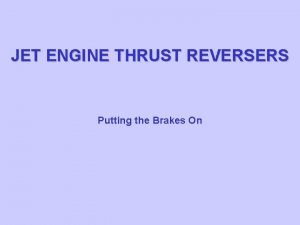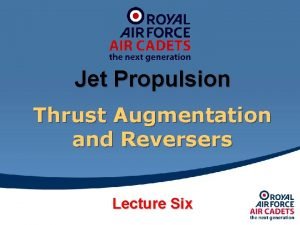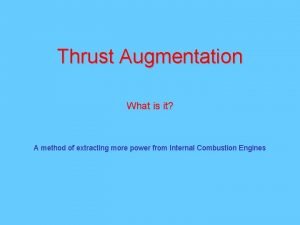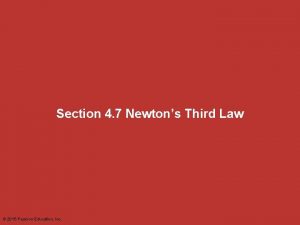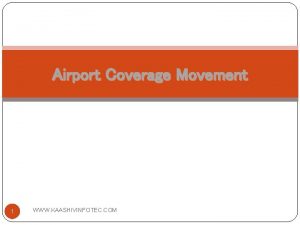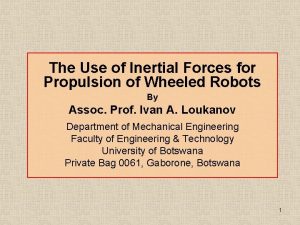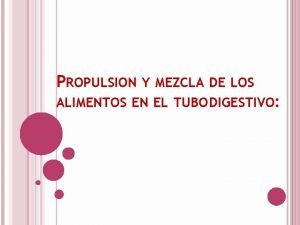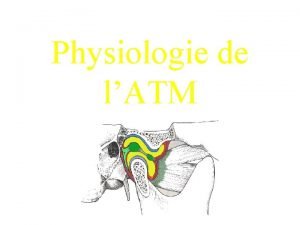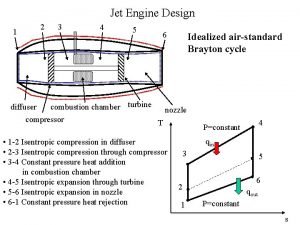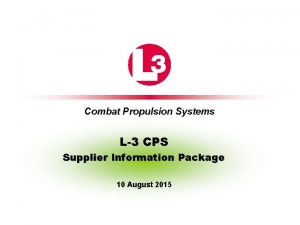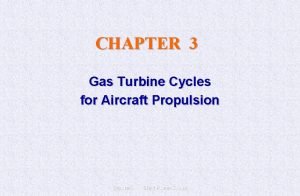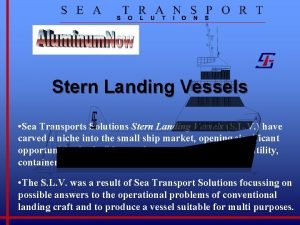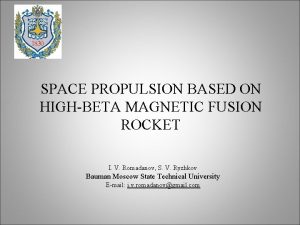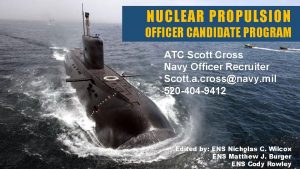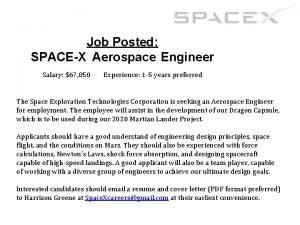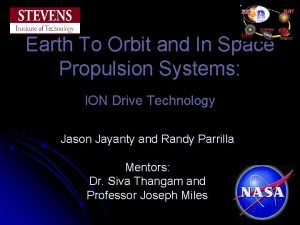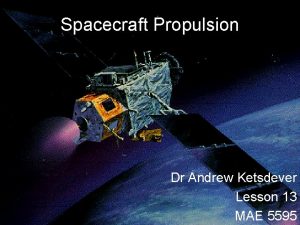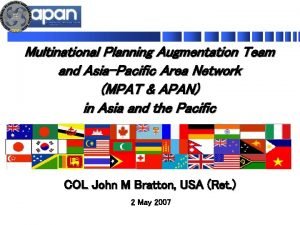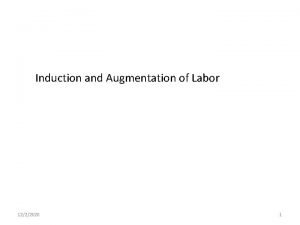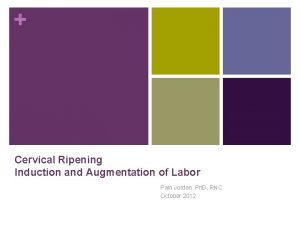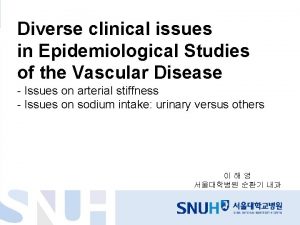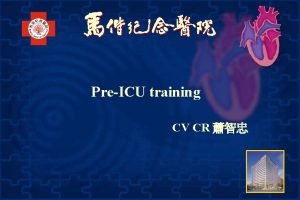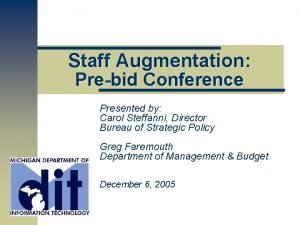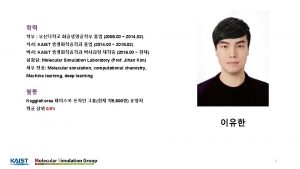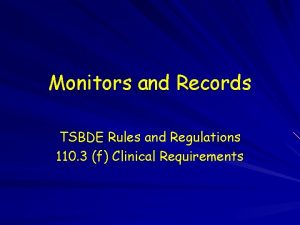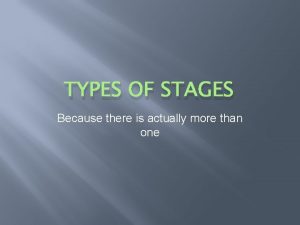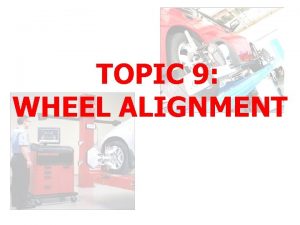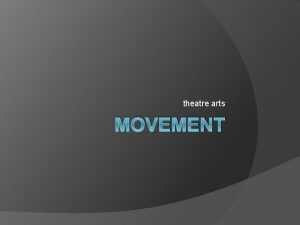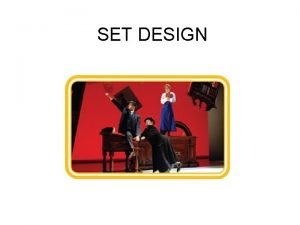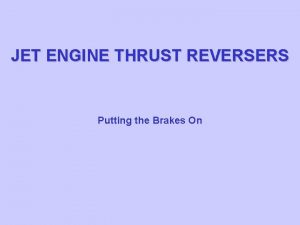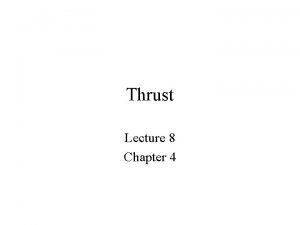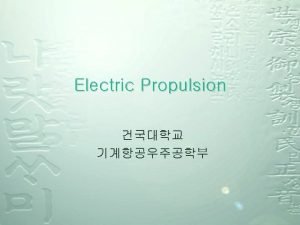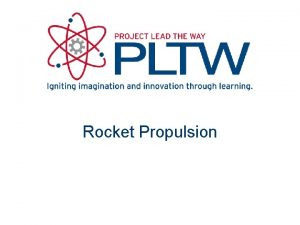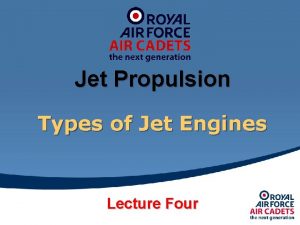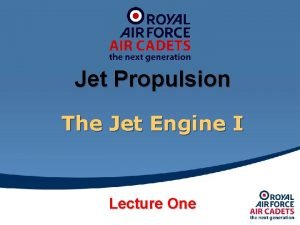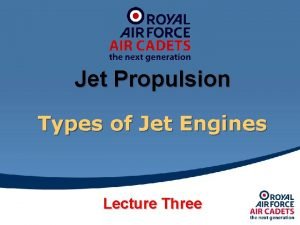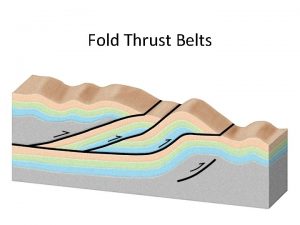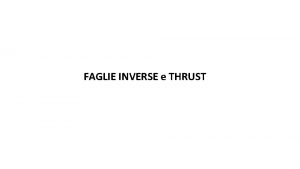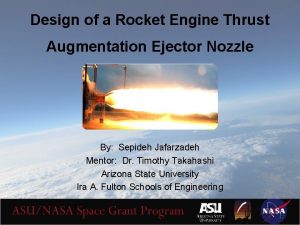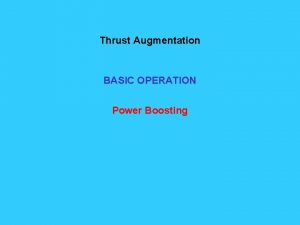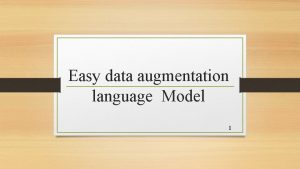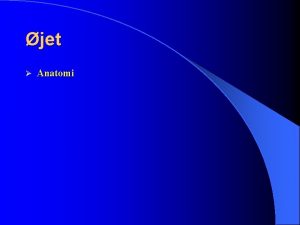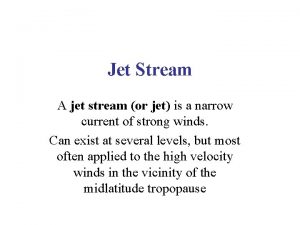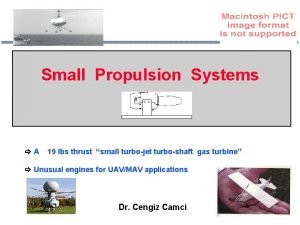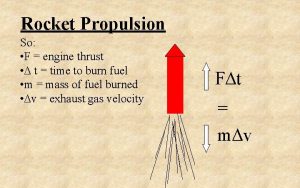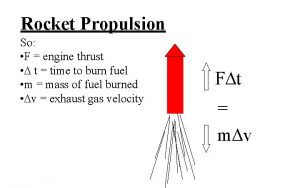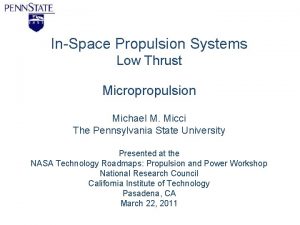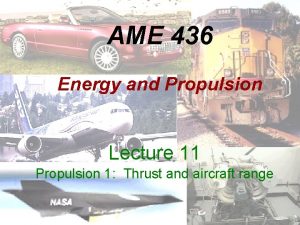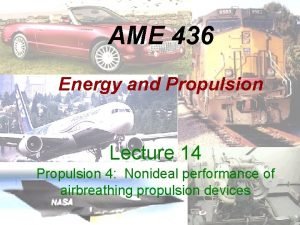Jet Propulsion Thrust Augmentation and Reversers Lecture Six








































- Slides: 40

Jet Propulsion Thrust Augmentation and Reversers Lecture Six

Thrust Augmentation Is a method of extracting more power from Internal Combustion Engines. It’s a form of ‘Power Boosting’ We shall examine two main types of augmentation systems, Water Injection and Reheat or Afterburning

Water Injection Systems Operation of either Water or Water Methanol systems cools the turbine, and allows water to be injected into the fuel spray nozzles which cools the air flow in the combustor allowing more fuel to be added.

Water Injection Rolls-Royce Spey Turbo Fan Series Increased Primary Fuel flow Combustion Chamber Water flow Water Injection allows water to be injected via additional nozzles built into the fuel spray nozzles. The water injection system automatically resets the fuel control unit to allow more fuel to flow. Water cools the turbine, and a cooler turbine means more fuel can be added.

Water Methanol Injection Dart Engine Turbo Prop Series Water Methanol Tank and Pump Water Methanol Control Unit The Control Unit switches the flow through the unit when the throttle moves to the take-off position. It also regulates the flow rate based upon engine power and atmospheric pressure. Water cools the turbine, and a cooler turbine means more methanol can be added.

The Re-Heat/Afterburn System Increases the exhaust jet velocity, and provides extra thrust without increasing the engine's frontal area.

The Re-Heat/Afterburn System Engine Rear End Reheat System (Afterburner) Jet Pipe Variable Nozzle Closed Spray Tubes Vapour Gutters Heat Shields The Jet Engine Re-Heat/Afterburn System The system consists of a larger diameter jet pipe, with internal heat shields. Inside are vapour gutters and fuel spray tubes. The variable nozzle is closed (reheat off) or opened (reheat on)

The Re-Heat/Afterburn System Engine Rear End Reheat System (Afterburner) Jet Pipe Gas stream without reheat Reheat/Afterburn consists of burning additional fuel in the jet pipe. Variable Nozzle Closed

The Re-Heat/Afterburn System Jet Pipe Variable Nozzle Closed Opens Gas stream with reheat The vapour gutters spray fuel into the gas stream. The Spray Tubes add more fuel to the process, which is fired by catalytic igniters, using oxygen from the combustion chambers. The variable nozzles are open to maintain pressure and to ensure reheat has no effect on the engine.

The Re-Heat/Afterburn System Visible ‘shock waves’ appear in the exhaust plume Concord was the only passenger aircraft to have Reheat/Afterburners. In military aircraft afterburner use is used for Take-off, In-flight acceleration and Combat only due to the extremely high fuel consumption rate.

Thrust Reversal is simply a method of altering Jet reaction from a rearward direction (which provides normal forward thrust) to a forward direction, providing reverse thrust (using the power as a decelerating force) and is operated by the pilot on landing.

Thrust Reversal Diverting some or all of a rearward directed jet in an almost forward direction, will provide a reverse thrust. The gas stream should be directed in a completely forward direction; but this is not possible for aerodynamic reasons. Yet an angle of 45 o to 90 o forward is common, giving reverse thrust up to 50% of forward thrust.

Thrust Reversers Translating Cowl Type TRANSLATING COWL Reverse Thrust BLOCKER DOORS Normal Forward Thrust TRANSLATING COWL Used on The Tri-Star and C 17 The C 17 deployment is extremely unusual in that it can deploy the thrust reversers in flight for a tactical descent from high altitude, thereby minimising the threat of anti-aircraft fire etc in a hostile area.

Thrust Reversers Pivoting Door Type PIVOTING DOOR Reverse Thrust Normal Forward Thrust Used on – PIVOTING DOOR The RAF Sentinel R 17 It comprises of two doors on this system, but multi door systems are replacing the translating cowl designs on high by-pass fan engines.

Thrust Reversers Clam Shell Door Type CLAM SHELL DOOR Reverse Thrust Normal Forward Thrust Used on – CLAM SHELL DOOR The VC 10 All four engines have the reverser fitted, but on RAF aircraft, the two inboard reversers have been inhibited because the jet blast from all four created too much buffeting on the fin and elevator.

Thrust Reversers Target Door Type TARGET DOOR Reverse Thrust Normal Forward Thrust Used on – TARGET DOOR The Tornado This system does redirect the jet thrust slightly forward, and causes exhaust staining on the aircraft fuselage and tail.

Thrust Reversers Other Methods REVERSE PITCH PROPELLER Reversing the pitch of the propeller blades sends the thrust in a totally forward direction. Used on the Hercules DROGUE PARACHUTE Parachutes can be deployed which increase the drag and increase the deceleration of the aircraft. Used on the Vulcan

Thrust Reversers Translating Cowl Type The Tri-Star and C 17 Pivoting Door Type The Sentinel R 17 Clam Shell Door Type The VC 10 Target Door Type The Tornado

Check of Understanding How does water injection increase power in a jet engine? It makes the combustion burn slower It heats the air flow into the engine allowing more fuel to be added It allows less fuel to be used It cools the air flow in the combustor allowing more fuel to be added

Check of Understanding Which of the following is a type of jet engine augmentation system? Rocket Boosting Water Injection Supercharging Turbocharging

Check of Understanding In a typical reheat system, oxygen is required in the jet pipe for combustion. Where does the reheat oxygen come from? Oxygen is pumped in with the extra fuel Slipstream air is scooped into the jet pipe Unburnt oxygen from the combustion chambers From on-board oxygen bottles

Check of Understanding Which sentence is true? Afterburning…. a. b. c. d. is restricted for take-off and combat. adds more fuel to the reheat section. results in an extremely high fuel consumption. produces visible shock waves in the exhaust. A and C only A, C and D only A, B, C and D

Check of Understanding After-burning in a jet engine involves burning additional fuel in the: Combustion Chamber Compressor Jet pipe Turbine

Check of Understanding What is the function of the Spray tubes in the afterburner? To inject water to control the temperature To add more air to the combustion process To control the afterburner internal pressure To add more fuel to the combustion process

Check of Understanding When is reheat used in a combat aircraft? At take-off For in-flight acceleration During combat manoeuvrings All of the above

Check of Understanding In a modern reheat system, how is the flame ignited? By the heat from the combustor By catalytic igniters By igniter plugs in the jet pipe By heat and compression

Check of Understanding Thrust reversers generally fall into four types, what are these types? Transmission cowl, pilot doors, crab shell doors and bucket doors Translating cowl, balanced doors, clamshell doors and target doors Translating cowl, pivot doors, clamshell doors and target doors Transmission cowl, pilot doors, clamshell doors and target doors

Check of Understanding What is thrust reversing? Turning the engine to point in the opposite direction Redirecting the engine exhaust in a forward direction Making the engine shaft rotate in the opposite direction Driving the aircraft wheels backwards

Check of Understanding Which type of thrust reverser is shown in the illustration? Translating cowl Clamshell door Pivot door Target door

Check of Understanding Reverse thrust is simply a method of altering what? Primary air-flow The engine cooling Jet reaction The engine RPM

Check of Understanding Which type of thrust reverser is shown in the illustration? Translating cowl Clamshell door Pivot door Target door

Check of Understanding Which of the following aircraft use the clamshell door system? Tornado Sentinel R 17 VC 10 Tristar

Check of Understanding Which type of thrust reverser is shown in the illustration? Translating cowl Clamshell door Pivot door Target door

Check of Understanding Which of the following aircraft use the target door system? Tornado Vulcan Hercules Tristar

Check of Understanding Which type of thrust reverser is shown in the illustration? Translating cowl Clamshell door Pivot door Target door

Check of Understanding Which of the following aircraft use the translating cowl system? C 17 Globemaster Vulcan R 17 Sentinel Hercules

Check of Understanding Which type of thrust reverser is shown in the illustration? Translating cowl Clamshell door Pivot door Target door

Check of Understanding Which of the following aircraft use the pivot door system? Tornado Sentinel R 17 VC 10 Tristar

Check of Understanding Which of the following statements applies to the process of afterburning, as used in some jet engines? It provides extra thrust without: Increasing the exhaust velocity Removing any more oxygen from the exhaust gases Increasing the engine's frontal area The use of additional fuel

Jet Propulsion End of Presentation
 Translating cowl thrust reverser
Translating cowl thrust reverser Thrust reverser types
Thrust reverser types Thrust augmentation methods
Thrust augmentation methods 10 year old sarah stands on a skateboard
10 year old sarah stands on a skateboard Yelvington jet aviation aircraft fuel
Yelvington jet aviation aircraft fuel 01:640:244 lecture notes - lecture 15: plat, idah, farad
01:640:244 lecture notes - lecture 15: plat, idah, farad Inertial propulsion
Inertial propulsion Propulsión en el sistema digestivo
Propulsión en el sistema digestivo Condyle orbitant
Condyle orbitant Jet engine diffuser
Jet engine diffuser L-3 combat propulsion systems
L-3 combat propulsion systems Turbojet vs turbofan
Turbojet vs turbofan Landing
Landing Magnetic space propulsion
Magnetic space propulsion Nuclear propulsion officer salary
Nuclear propulsion officer salary Spacex chemical engineer salary
Spacex chemical engineer salary Siva de scalzo
Siva de scalzo Nuclear propulsion
Nuclear propulsion Propellantless propulsion
Propellantless propulsion демо
демо Variety brand
Variety brand Mnf sop
Mnf sop Staff augmentation synonym
Staff augmentation synonym Augmentation of labour
Augmentation of labour Augmentation of labour
Augmentation of labour Boob job dubai
Boob job dubai Augmentation index
Augmentation index Cheek filler dubai
Cheek filler dubai Pcwp waveform
Pcwp waveform Staff augmentation
Staff augmentation Phx breast augmentation
Phx breast augmentation Data augmentation numerical data
Data augmentation numerical data A polygon with six congruent sides and six congruent angles
A polygon with six congruent sides and six congruent angles Stage right and left
Stage right and left Tsbde rules and regulations chapter 110
Tsbde rules and regulations chapter 110 Traverse staging pros and cons
Traverse staging pros and cons El pasado simple de drink
El pasado simple de drink Wheel alignment setback
Wheel alignment setback Blocking notation theatre
Blocking notation theatre Contoh panggung thrust
Contoh panggung thrust Proscenium arch stage drawing
Proscenium arch stage drawing
